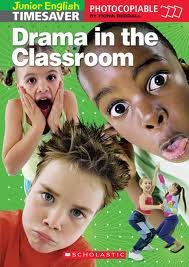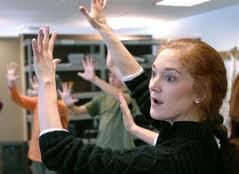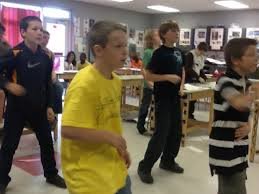Education Drama & Dance
Dramatic Curriculum Enactments
Overview
All i.pel integrated digital curriculum will be scripted so students can “enact,” the lesson. The purpose of engaging these drama activities to the curriculum is to create a variety of complex opportunities that can help further develop skills within reading, speaking, written and composition.
The chapter scripts will be formatted in 3, 10 and 30 minute supplements. They can be used to supplement student learning in quick segments or can be made into full productions which can be performed by the school’s drama club.
The history of Drama in Education
As mentioned above the use of drama engagements to educate has been used over the course of history from the time of Aristotle and was the beginning of the progressive movement in education, where emphasis was placed upon “doing” rather than memorizing. This is part of the Blended-based Learning model which in line with the Common Core Standards which are emphasizing more of a Project-based learning model. Integrating drama helps children in various ways.
Escape Room Adventures
One of the fastest growing Dramatic Curriculum Enactments is the Escape Room Adventure. In a leap from video screen to reality, escape room adventures require people locked in actual chamber to solve clues, get out within an hour. In K-12 the classroom is substitutes for the chamber.
These classroom enactment are inspired by the 1980s children’s game book Choose Your Own Adventure a series where each story is written from a second-person point of view, with the reader assuming the role of the protagonist(s) and making choices that determine the main character’s actions and the plot’s outcome.
The protagonist takes on a role relevant to the adventure such as a private investigator, mountain climber, race car driver, doctor, or spy. Stories are, for the most part, generally gender and race neutral. Depending on the story the protagonist can be either a child or young adult and all players can be the main character in the story, not watching the character.
The stories are formatted so that, after a couple of pages of reading, the protagonist faces two or three options, each of which leads to more options, and then to one of many endings. The number of endings is not set, and varies from as many as 12 to 40. There is no clear pattern among the various titles regarding the number of pages per ending, the ratio of “good” to “bad” endings, or the reader’s progression backwards and forwards through the pages of the book. This allows for a realistic sense of unpredictability, and leads to the possibility of repeat readings, which is one of the distinguishing features of the books.
Because of video games and the internet everything seems to be interactive and these classroom enactments seem like a video game only life size as they combine digital culture with an older form of entertainment, in this case, theater. Basically they combine puzzle solving with theater as they allow students to have direct influence over the actual outcome of the drama, not merely what to look at, where to go, when to change directions.
The classroom “locks” students behind closed doors and asks them to find a way out by solving puzzles and cracking codes all within one class period or 45 minutes. Students race the clock as they try to decipher clues to reveal the combination of a lock that opens a chest that hides photographs that contain hints on how to read a map that leads to another mystery within another mystery within another mystery; or finding a battery to play a message on a voice recorder and a flash drive that was later inserted into a computer that played a video that leads to . . . more clues.
One enactment is played at a table that is set with sharpened pencils, clipboards, a sealed envelope and a small chest with a four-number lock attached to it. Students are tasked with solving a maze, math problems, a crossword-like puzzle, a logic game involving colors, several letter-based codes and more.
Also, unlike a video game, all five senses can be involved. For example, having a “smelly clue” in a detective enactment in which a box containing vials marked “evidence” emits a familiar odor.
All K-12 curriculums can be adapted to classroom enactment including all the core STEM subjects. Enactments use the teaching/learning platforms of inquiry, project, problem and blended-based learning and require the use of critical thinking, collaboration, communication and creativity.
Drama in the Classroom
(The following is abstract from “12 Fascinating Ways to Use Drama in the Curriculum” By: Loriana Romano, Lisa Papa, and Elita Saulle)
1. Drama is part of real life and prepares students to deal with life’s problems.
Drama simply allows students the opportunity to rehearse roles, further giving form or shape to the individual and personal ideas and feelings they are naturally experiencing. Overall, this allows students to make sense out of their ‘real’ life problems.
2. Drama engages students in creative problem-solving and decision making.
Deep experiences through drama guides and supports student’s problem solving skills, while at the same time, works to encourage an increasing awareness in how to solve issues at hand. Instead of school just being a place where students are being taught and told what to think and feel, drama turns this into a deeper experience in thinking, further motivating students to question, respond, and explain what they are feeling and thinking.
3. Drama develops verbal and nonverbal communication.
Through different characters, students share the opportunity to expand their problem solving skills both verbally and non-verbally, making room for a sense of creativity. As well, students practice and build upon various communication skills through the use of body language, facial expressions and different voices.
4. Drama can enhance students’ psychological well-being.
Under different characters, students can express their true feelings or sense of personality without fear of being judged or criticized. They can work on personal issue or solve personal problems while in character, which can simply help their overall well-being. Essentially, what this does is allow students to get things off their mind, further releasing emotion and tension and allowing students to be who they are.
5. Drama develops empathy and new perspectives.
Taking on various roles in character allows students to use all senses and characteristics in order to understand the character, as well as, the scenario or story at hand. Learning how to express oneself in different ways and through different means, helps build a strong character and personality.
6. Drama builds cooperation and develops other social skills.
Working together as a group promotes, encourages and motivates cooperation. It is essential that each of our students feels accepted and works well with others, in order to create and build a safe environment for all to learn. What drama does is continues to build on this importance. Drama simply brings students together, allowing them to find different characters that best suits them, different roles to express who they are, and different ways to build upon and develop social awareness.
7. Drama increases concentration and comprehension through engagement.
Students always learn best when they are engaged and interested, as well as, when they are actively involved. As students are strongly focused and concentrating, their overall understanding simply increases. When we include students in our examples in class, it is more likely that they will grasp the idea more, or make a concrete connection. Drama allows us to do this with our students.
8. Drama helps students consider moral issues and develop values.
Drama simply helps students further understand the importance of values they are already aware of, as well as, it guides them in developing and forming additional values. As teachers, it is essential that we allow students the space and opportunity to make this discovery and connection in values and moral issues while they are engaged through drama, rather than impose them.
9. Drama is an alternative way to assess by observing (externalization).
When teaching new lessons, we always depend on prior knowledge. We start with what students know, which further guides us with the next step to take in our teaching. It is difficult for some of our students to make sense of specific things which is simply where drama fits in. Drama can be used to preview or review a lesson; further allowing teachers to assess what students already know or have learned.
10. Drama is entertaining. Fun is learning, and learning is fun.
If we remember this and try to incorporate fun in our teaching, our students will definitely enjoy the learning process. Students enjoy dealing with and discussing real life issues and problems, they like figuring things out, doing interesting things, doing things differently – drama gears towards this and more.
11. Drama contributes to aesthetic development. ![]()

Through drama, students learn about a number of things such as conflict and characters, which further allows them to deepen their sensory awareness. In addition to, children also ![]() learn how to express themselves through various teaching and learning strategies such as dialogue and improvisation.
learn how to express themselves through various teaching and learning strategies such as dialogue and improvisation.
12. Drama offers a learning avenue that enhances other areas of the curriculum.
Drama can be used as a teaching and learning tool to help students make meaning of a number of skills they need to be a well-rounded individual. It further allows them to experience and explore the world around them through different characters and roles, further building on their relationship with others and things.
In connection to the ways in which integrating drama can help students learn, we have created a list of great activities further emphasizing some of the creative ways drama enhances the classroom environment while also building upon a child’s development. These great activities, among many others, can also be found in ‘The Arts as Meaning Makers’, written by Claudia E. Cornett and Katharine L. Smithrim.
Energisers & Warm-ups
Energizers and warm-ups aim towards helping students to unwind and relax, get them focused, and to simply set the atmosphere.
Paraphrasing: K – adult
• Have the children stand up or sit in a circle
• Turn to the student on your left and ask a question – example: What is your favorite color? Or holiday or fruit or game and so forth
• The student gives an answer [example: red]
• Student who asks the question repeats the answer back to the student – example: What is your favorite color Lisa? Lisa: My favorite color is red – Student repeats Lisa’s favorite color is red
• All around the circle until everyone has had a chance to ask and paraphrase
• Reflective questions could be asked such as – What similarities did you notice?
Spider Web: K – adult
For this energizer you need a ball of wool.
• Holding a ball of wool have the students begin by stating their name or something pertaining to themselves or something related to the lesson – example: My name is Nancy, I love to walk.
• The student [Nancy] is than required to pass the yarn to another student
• This process goes around until all the students have had a turn
• If time permits the yarn can be passed in reverse and the student is required to say the name out loud along with a part of the statement given by the last student – example: Nancy you love to walk
Mime Exercies
Mime exercises help further develop oral expression and self-esteem. By using attentiveness, students further develop their observational skills through focus and detail.
Number Freeze
• Students are grouped in assigned numbers – than given a setting by the teacher (ex.farm)
• Teacher calls a number and the students mime an action from the designated setting – example: they may act like a cow
• Next number group is called and they are to mime their designated setting while the other observe
Dialogue Tableaux
Students can group in pairs or small groups to act out a scene. The audience must respond to the scene by telling that they see.
Verbal Strategies
Verbal strategies can be used to review lessons, or for predicting, analyzing material and so forth.
Pair Sound Effects:
• Students are paired and given a letter A or B to choose from
• A makes a sound
• B coordinates the action of A’s sound
• A variation of this strategy could be A makes a sound according to B’s action
Language
Reader’s Theatre: Students will read a story or part of a story. They will choose specific characters within the story to play out.
Storytelling
The greatest way to motivate the mind is through storytelling because through this flows the power of imagination.
Puzzle Creation
Each student is given a puzzle piece. They are responsible for writing or drawing a short story about a particular area of interest. This could be related to math, science, social studies and so forth. The students use their puzzle piece connecting it to the match.
Math
Fraction Mime
After introducing the concept of fractions, use an open space to have the whole group practice dividing themselves up to solve problems that are given: divide in half, fourths, thirds. When numbers are uneven, ask how this can be shown.
DANCE
Many students who are thought to suffer from ADD are actually kinetic learners (see Balance-based Learning). As such they have to m ove to learn. As adults, many times these students will stand to work at tall desks or tables. All i.pel integrated digital curriculum contains dance supplements to accommodate kinetic learners.
Dance develops the ability of students to communicate and express themselves through movement. Through dance, students develop awareness of the ways their body’s move, the space in which they move, the time and quality of their movement and their relationship to each other and objects. Students participate in composing moving and appreciating a range of dance styles. i.pel’s dance supplements provide support for teachers in the implementation of dance in the curriculum.



Recent Comments